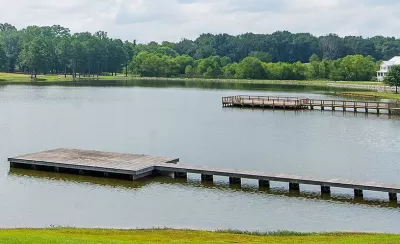How one master-planned development used lower-density urbanism principles to build a community focused on affordability, sustainability, and conservation.

In a long read in Common Edge, Steve Mouzon defends the utility of lower-density zoning and New Urbanist principles that may be more appropriate in certain settings, including places already slated for sprawl, with existing sprawl, or growing small towns.
The best vehicle for implementing principles illustrated here at the scale of a neighborhood, hamlet, or village is not a major production builder, as these principles violate almost all of their conventional industrial practices. Instead, look to the record of stronger New Urbanist developers who are no strangers to doing things considered unconventional by the Industrial Development Complex in the interest of better places with stronger lifetime returns.
Mouzon outlines his four principles for accomplishing lower-density urbanism in suburban and small town settings. These include compact development that allows for preservation of open space, “listening to the land,” creating a range of housing values, and bringing in a mix of uses.
Mouzon uses the example of a community called the Waters, a project he worked on near Montgomery, Alabama, describing how conscious design decisions helped the development reduce needed infrastructure, conserve more open space and preserve the character of the site, create opportunities for social interaction through front-facing porches and walkable spaces, and raise property values. The article offers an in-depth and instructive look at how a from-scratch planned development can use design principles to limit sprawl and conserve open space.
FULL STORY: What’s the Point of Lower-Density Urbanism?

Alabama: Trump Terminates Settlements for Black Communities Harmed By Raw Sewage
Trump deemed the landmark civil rights agreement “illegal DEI and environmental justice policy.”

Planetizen Federal Action Tracker
A weekly monitor of how Trump’s orders and actions are impacting planners and planning in America.

How Atlanta Built 7,000 Housing Units in 3 Years
The city’s comprehensive, neighborhood-focused housing strategy focuses on identifying properties and land that can be repurposed for housing and encouraging development in underserved neighborhoods.

Report: Zoning Reforms Should Complement Nashville’s Ambitious Transit Plan
Without reform, restrictive zoning codes will limit the impact of the city’s planned transit expansion and could exclude some of the residents who depend on transit the most.

Judge Orders Release of Frozen IRA, IIJA Funding
The decision is a victory for environmental groups who charged that freezing funds for critical infrastructure and disaster response programs caused “real and irreparable harm” to communities.

‘Clybourne Park’ Sets Stage for Housing Equity Discussions
Clybourne Park, a play exploring race, real estate, and community tensions, can set the stage for discussion on the lasting impacts of housing discrimination, gentrification, and the fight for affordability.
Urban Design for Planners 1: Software Tools
This six-course series explores essential urban design concepts using open source software and equips planners with the tools they need to participate fully in the urban design process.
Planning for Universal Design
Learn the tools for implementing Universal Design in planning regulations.
Caltrans
Smith Gee Studio
Institute for Housing and Urban Development Studies (IHS)
City of Grandview
Harvard GSD Executive Education
Toledo-Lucas County Plan Commissions
Salt Lake City
NYU Wagner Graduate School of Public Service





























